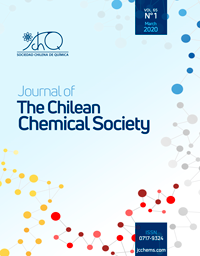
- Sediments,
- heavy metals,
- labile fraction,
- seasonal variation,
- cluster analysis
Copyright (c) 2020 Journal of the Chilean Chemical Society

This work is licensed under a Creative Commons Attribution-NonCommercial-ShareAlike 4.0 International License.
Abstract
Total concentrations of heavy metals can provide information on sediment contamination levels. However, such information alone is insufficient to understand the mobility, bioavailability and toxicity of these elements in the sediment. In this study we analyze the seasonal and spatial variation of labile fraction heavy metal concentration in three Chilean river basins. We also study the impact of mining nearby in the Cu concentrations in one of the sites studied in the three basins. Samples were taken in spring, summer, autumn and winter. Three selected basins were: Aconcagua (V Region), Cachapoal (VI Region) and Choapa (IV Region); sediments were collected at six different points of the river basins (E1-E6). For the labile orsoluble fraction of Al, As, Cd, Cu, Cr, Fe, Mn, Mo, Ni, Pb and Zn, 0.25 g of sediments were stirred with 40 mL acetic acid 0.11 mol L-1for 16 h at room temperature. Metals were analyzed by ICP-OES. The eleven heavy metals analyzed in the labile fraction were detected in the three basins in most of the stations. The high concentration of Cu in the labile fraction found in the E2 site in the three basins demonstrates the influence of mining activities near this site. The mobility of Cu to other sites is depending on the characteristics of the basin. Variation between seasons was observed.

References
- X. L. Gao. A. C. T. Chen,.¿ Water Res 46, 1901, (2012).
- R. K. Klake, V. K. Nartey, L. K. Doamekpor, K. A. Edor, J. Environ Prot. 3,1070, (2013).
- M. Karvelas, K. Athanasion , C. Samara, Chemosphere 53, 120, (2003).
- G. R. Mataba, V. Verhaert, R. Blust, L. Bervoest, Sci Tot Environ. 547, 48, (2016).
- S. K. Gupta, M. Chabukdhara, J. Singh, F. Bux, Ecol. Risk Assess 21, 227, (2015).
- M. D. Subida, A. Berihuete, P. Drake, J. Blasco, Sci. Total Environ 450-451, 280, (2013)..
- A. Borja, H. Heinrich, Mar Pollut. Bull 50, 486, (2005).
- K. Sebakira, H. Oryem Origa, T. A. Basamba, G. Mutumba, E. Kakudidid, In J Environ Sci Technol 7, 435, (2010).
- X. Yuan, L. Zhang, J. Li, C. Wang, J. Ji, Catena 119, 52, (2014).
- S. Peng, W. Wang, X. Li, Y. Yen, Chemosphere 57, 839, (2004).
- A. Tessier, P. G. Cambell, M. Bisson, Anal. Chem. 51, 844, (1979).
- S. V. Copaja, M. X. Molina, R.M. Tessada, J. Chil. Chem. Soc., 59: 2353, (2014).
- J. Y. Kim, B. T. Lee, K. H. Shin, K. W. Kim, K. G. An, Y.S. Park, Y. Kim, Y. H. Kwon, Environ Monit. Assess 129, 79, (2007)
- C. H. Qu, C. Z. Chen, J. R. Yang, L. Z. Wang, Y. L. Lu, Estuaries 16, 475, (1993).
- R. Oyarzun, S. Guevara, J. Oyarzun, H. Lillo. P. Higueras, Geochem. Health 28, 431, (2006).
- R. Oyarzun. J. Oyarzun. J. Lilo. H. Maturana. P. Higueras, Environ geol. 52, 283, (2007).
- T. Vila. R.H. Sillitoe, Econ. Geil 86, 1238, (1991).
- T. Ditmar. Total environ. 325, 193, (2004).
- DGA (Dirección General de Aguas). Caracterización de Sedimentos Fluviales y su Relación con la Calidad del agua, pp 1-80, (2008).
- F.R. Hauer, G.A. Lamberti, Methods in Stream Ecology, Second Ed., (Academic Press, USA, 1996).
- R.L. Welcomme, Documentos Técnicos de Pesca N°202, FAO, 1-62 (1980).
- S. I. Simpson, G. E. Batley, A. A. S. Charlston, J. L. Dtauber, C. K. King, J. C. Chapman, R. V. Hyne, S. A. Gale A. C. Roach, W. A. Maher, J. J. Sharyan, Handbook for Sediment Quality Assessment, (CSIRO Bangor, NSW), 2005; pp 9-19
- P. L. Blackemore, B. K. Searle. B. K. Daly, (1987) In Methods for Chemical Analysis of Soils, N. Z. Soil Bureau Scientific Report 80, p 18.
- M. A. Sadzawka, A. Carrasco, R. Grez, M. Mora, H. Flores, A. Newman, Instituto de Investigaciones Agropecuarias (INIA). Serie Actas INIA N0 34 (2006).
- Cluster analysis electronic Text Book statarSoft “Copyright StataSoft, in 1984-2004.
- S. V. Copaja, G. Díaz, R.Toro, R. M. Tessada, P. Miranda , J. R. Morales, J. Chil. Chem. Soc., 57, 1199, (2012).
- J-G. Lin, S-Y. Chen, Environ Int 24, 345, (1998).
- S. V. Copaja, V. R. Nuñez, G. S. Muñoz, G. L. González, I. Vila, D. Véliz, J Chil Chem Soc. 60, 2642, (2016).
- F. Burriel, F. Marti, S. Lucena-Conde, J. Arribas-Jimeno, Hernández Méndez (2003) Química Analítica Cualitativa (Décimo Sexta Edición) (Editorial PARANINFO) Madrid, España. Chapter XIX y XX..
- C.A. B. Garcia, M. S. Barreto, E. A. Passos, J. Patrocínio, H. Alves, J. Braz. Chem. Soc. 20. 1334, (2009).
- Yi Wai. Chiang, K. Ghyselbrecht, R. M. Santos, J. A. Martens, R. Swennen, V. Cappuyns, B. Meesschaert, Chemical Engineering Journal 405, 200, (2012).
- G. F. Birch, S. E. Taylor, C. Matthai, Environ Pollut. 113, 357, (2001).
- D. Soumady, S. Asokan, Int. Pharma. Sci. 1, 42, (2011).
- V. W. Shulkin. B. J. Presley. W. Kavum, Environ. Int. 29, 493, (2003).

